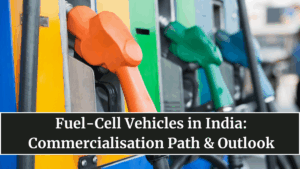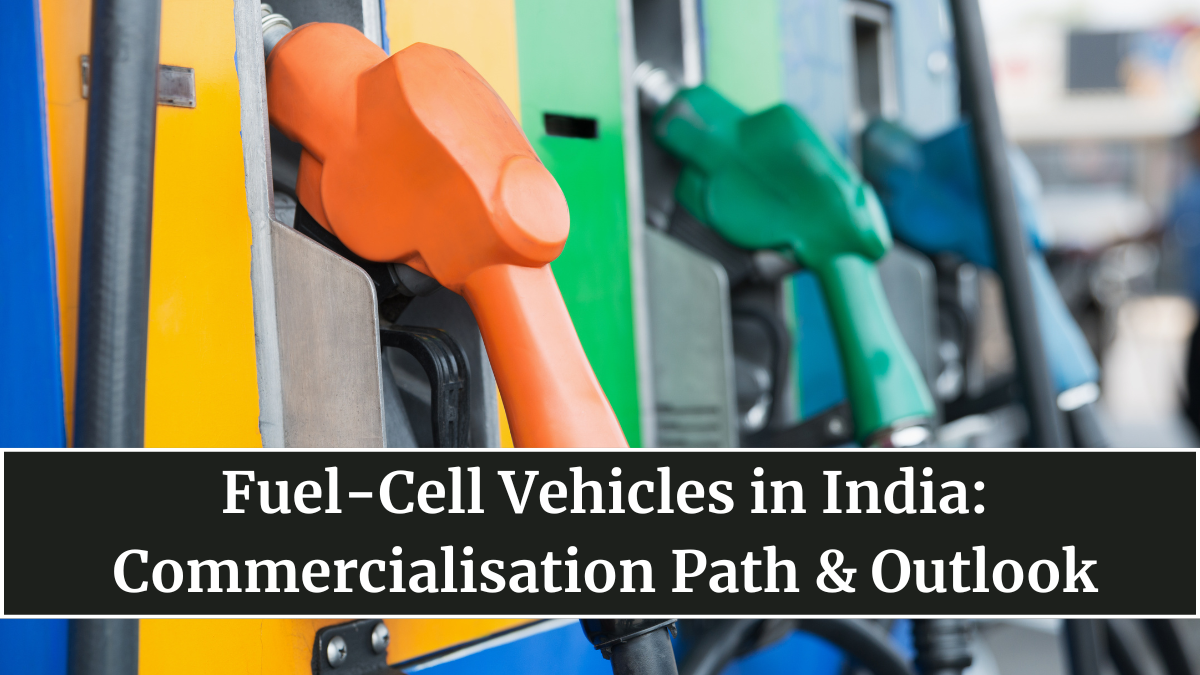India’s clean mobility revolution has entered a new phase — one powered by hydrogen fuel-cell technology. Once seen as a distant dream, fuel-cell vehicles (FCEVs) are now beginning to move from research labs to real-world roads. With government incentives, pilot programs, and partnerships between automakers and energy firms, 2025 marks the start of India’s hydrogen mobility era.
As electric vehicles dominate the headlines, fuel-cell cars are quietly offering a powerful alternative: longer range, faster refueling, and zero tailpipe emissions. The question now is not whether India will adopt hydrogen vehicles — but how quickly they can scale commercially.

Understanding Fuel-Cell Vehicle Technology
Fuel-cell vehicles use hydrogen gas to generate electricity through a chemical reaction inside a fuel cell stack. The only by-product? Pure water vapor.
Here’s how it works:
-
Hydrogen stored in the tank passes through a fuel cell stack.
-
Inside, it reacts with oxygen from the air using a platinum catalyst.
-
The process generates electricity, which powers the vehicle’s motor.
Unlike battery EVs, FCEVs don’t need long charging times — refueling takes just 3–5 minutes, and most can travel over 600 km per tank.
This makes them especially ideal for long-haul commercial fleets, buses, and logistics trucks that require continuous operation.
India’s Roadmap for Hydrogen Mobility
The Indian government has placed hydrogen at the heart of its National Green Hydrogen Mission (NGHM) launched in 2023, aiming to make India a global leader in hydrogen production and mobility solutions.
Key goals under the 2025 plan include:
-
Establishing 100+ hydrogen refueling stations nationwide.
-
Commercial deployment of fuel-cell buses and heavy-duty vehicles.
-
Integration of FCEV technology in public and intercity transport.
-
Domestic production of green hydrogen using solar and wind energy.
-
Collaboration between automakers, PSUs, and private startups for vehicle development.
This framework creates a direct path toward large-scale commercialisation of hydrogen-powered mobility by 2030.
Major Industry Players Driving the Transition
Several companies are leading India’s hydrogen vehicle journey:
-
Toyota Kirloskar Motor: Testing the Mirai FCEV in collaboration with the government under a pilot project in Delhi and Bengaluru.
-
Tata Motors: Developing hydrogen fuel-cell buses for public transport fleets.
-
Ashok Leyland: Working with NTPC and Indian Oil Corporation (IOC) on heavy-duty hydrogen truck prototypes.
-
Reliance Industries and Adani Group: Investing heavily in green hydrogen production infrastructure.
Public-private collaboration has become the backbone of India’s fuel-cell ecosystem, bridging the gap between research and real-world deployment.
Economic and Environmental Impact
Fuel-cell vehicles bring a dual advantage to India’s economy and environment:
Economic Benefits:
-
Reduces crude oil imports, saving billions in foreign exchange.
-
Creates new jobs in hydrogen production, logistics, and maintenance.
-
Encourages domestic manufacturing of high-value components like membranes and stacks.
-
Stimulates investment in renewable energy and infrastructure.
Environmental Gains:
-
Zero tailpipe emissions — only water vapor.
-
Significant reduction in carbon and particulate pollution in urban areas.
-
Promotes renewable hydrogen integration into the energy grid.
By replacing diesel and petrol fleets with hydrogen-powered systems, India can drastically cut transport-sector emissions within this decade.
Challenges Slowing Down Commercialisation
Despite its promise, hydrogen mobility faces multiple challenges on the road to mass adoption:
-
High production costs: Green hydrogen is still expensive at around ₹500–600 per kg.
-
Limited infrastructure: Refueling networks are sparse outside pilot zones.
-
Storage and safety: Hydrogen requires high-pressure tanks and specialized handling.
-
Technology localization: Most components are imported, raising costs.
-
Consumer awareness: Few people understand hydrogen’s potential or safety features.
Addressing these gaps will require a combination of policy incentives, R&D funding, and public awareness campaigns.
The Future Outlook for FCEVs in India
India’s transition to fuel-cell vehicles will likely follow a phased approach, starting with heavy commercial vehicles and expanding to passenger cars.
Expected milestones by 2030:
-
Over 25,000 hydrogen buses operating in metro and intercity routes.
-
Hydrogen refueling corridors across Delhi–Mumbai and Chennai–Bengaluru highways.
-
Domestic manufacturing of fuel-cell stacks under the Make in India initiative.
-
Green hydrogen cost reduction by up to 40% through renewable energy integration.
-
Entry of global players like Hyundai and Honda into the Indian FCEV market.
With sustained government support and industrial collaboration, India is on track to become one of Asia’s top three hydrogen-powered economies by the end of this decade.
The Hydrogen Mobility Revolution Has Begun
While battery EVs dominate urban commutes, hydrogen fuel-cell technology is set to power the backbone of Indian transportation — from long-haul freight to intercity travel.
The future of Indian roads lies in synergy, not competition, between batteries and hydrogen — both driving toward the same goal: a cleaner, energy-secure, and emission-free nation.
FAQs
What is a fuel-cell vehicle (FCEV)?
A fuel-cell vehicle uses hydrogen to produce electricity that powers its motor, emitting only water vapor instead of pollutants.
Are hydrogen vehicles better than electric vehicles?
They’re not competitors but complements — FCEVs offer faster refueling and longer range, while EVs suit shorter urban drives.
How many hydrogen fuel stations are there in India?
As of 2025, fewer than 20 pilot stations exist, but over 100 are planned under the National Green Hydrogen Mission.
Which companies are developing hydrogen vehicles in India?
Toyota, Tata Motors, Ashok Leyland, and Indian Oil Corporation are leading hydrogen mobility initiatives.
When will hydrogen cars be available to the public in India?
Mass-market availability is expected around 2027–2028, starting with fleets, buses, and later premium passenger vehicles.
Click here to know more.
